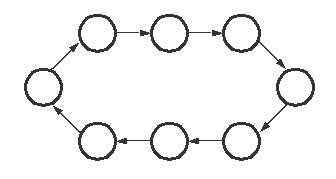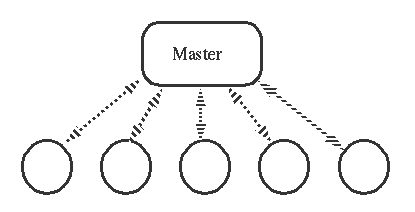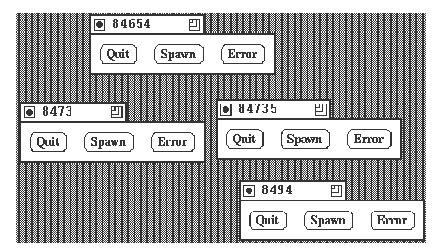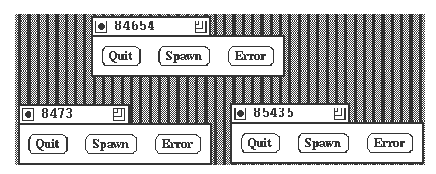

Start Erlang.
Give the command c:c(demo). to compile the file.
Try running the query:
demo:double(12).
This is just to test if you can get the system started and can
use the editor together with the Erlang system.2. Write a function temp:convert(Temperature) which combines the functionality of f2c and c2f. Example:
> temp:convert({c,100}).
=> {f,212}
> temp:convert({f,32}).
=> {c,0}
3. Write a function mathStuff:perimeter(Form) which computes the perimeter of different forms. Form can be one of:
{square,Side}
{circle,Radius}
{triangle,A,B,C}
Back to top
2. Write a function lists1:max(L) which returns the maximum element of the list L.
3. Write a function lists1:min_max(L) which returns a tuple containing the min and max of the list L.
> lists1:min_max([4,1,7,3,9,10])
{1, 10}
4. Write the function time:swedish_date() which returns
an atom containing the date in swedish YYMMDD format:
> time:swedish_date()
'901114'
Hints: trying looking up date() and time() in the manual,
You may also need number_to_list/1, list_to_atom/1. Try
giving the shell queries to see what these BIF's do.)

2) Write a function which starts N processes in a ring, and sends a message M times around all the processes in the ring. After the messages have been sent the processes should terminate gracefully.

3) Write a function which starts N processes in a star, and sends a message to each of them M times. After the messages have been sent the processes should terminate gracefully.


Write a module ms with the following interface:
start(N) - Start the master and tell it to start N slave proc- esses. Register the master as the registered process master.
to_slave(Message, N) - Send a message to the master and tell it to relay the message to slave N. The slave should exit (and be restarted by the master) if the message is die.
The master should detect the fact that a slave processe diea nd restart it and print a message that it has done so.
The slave should print all messages it recieves except the message die
Hints:
The master should trap exit messages and create links to all
the slave processes.
The master should keep a list of the process id's (pid's) of the slave processes and their associated numbers.
Example:
> ms:start(4).
=> true
> ms:to_slave(hello, 2).
=> {hello,2}
Slave 2 got message hello
> ms:to_slave(die, 3).
=> {die,3}
master restarting dead slave3
To illustrate this we are going to use the Interviews interface and having each process represented by a window on the screen.
Excercise: Create a window containing three buttons: Quit , Spawn , Error.
The Spawn button shall create a child process which displays an identical window.
The Quit button should kill the window and its child windows.
The Error button should cause a runtime error that kills the window (and its children), this window shall then be restarted by its parent.
Example: When we start our program, a window like this should appear:

Let us now press the Spawn button twice and as result, two child windows will pop up on our screen. Our screen will now look something like this:

As you can see the windows are tagged with a number so it is easier for us to refer to them. The parent window has the number 84654 and its two childs number 8473 and 84735. Each child may have childs of its own, e.g press the Spawn button on window 84735 and we will have the following picture:

The window 8494 is a child to window 84735.
Now lets press the Error button in window 84735. Now a runtime error will occur in the process for that window and the process (and the window) will die. This shall cause the child 8494 also to die and the parent 84654 to start up a new child window.
The result will look something like this:

The new child got number 85435.
This can be implemented using the client/server concept with a process on each side listening to a socket for messages.
(Hints: read the User's Guide p.37 and the BIF Guide p.11)
#include <stdio.h>
#include <fcntl.h>
#include <sys/types.h>
#include <sys/socket.h>
#include <netinet/in.h>
#include <netdb.h>
#include <errno.h>
/*--- Setup a socket to Host using Port , return the filedesc. ---*/
static int setup_socket( hostname , port )
char *hostname;
int port;
{
struct sockaddr_in serv_addr;
int sockfd;
struct hostent *hp;
/*--- Get the address of the host ---*/
if ((hp = gethostbyname( hostname )) == (struct hostent*) 0) {
perror("From gethostbyname \n");
exit(-1);
}
/*--- Fill in the address to the remote system ---*/
bzero((char *) &serv_addr , sizeof(serv_addr));
serv_addr.sin_family = AF_INET; /* Protocol family */
serv_addr.sin_port = htons( port ); /* The port number */
bcopy(hp->h_addr_list[0] , /* The net address to the host */
(char *) &serv_addr.sin_addr.s_addr ,
hp->h_length);
/*--- Create the socket ---*/
if ( (sockfd = socket( AF_INET , SOCK_STREAM , 0 )) < 0) {
perror("setup_socket: socket");
exit(-1);
}
/*--- Connect to the other system ---*/
if (connect(sockfd, &serv_addr, sizeof(serv_addr)) < 0) {
perror("setup_socket: connect");
exit(-1);
}
else
return sockfd;
}; /* setup_socket */
echo -n "dh32d8yhd8" > ~/.erlang.cookie
chmod 400 ~/.erlang/cookie ).
erl -name bill -cookie
PGM -> e PGM -> CLAUSE PGM CLAUSE -> LITERAL TAIL . LITERAL -> predsym PARLIST PARLIST -> e PARLIST -> ( ARGLIST ) ARGLIST -> TERM ARGTAIL ARGTAIL -> e ARGTAIL -> , ARGLIST TERM -> csym TERM -> varsym TAIL -> e TAIL -> :- LITLIST LITLIST -> LITERAL LITTAIL LITTAIL -> e LITTAIL -> , LITLISTThis grammar will accept Datalog programs, for example:
path(stockholm,uppsala).
or:
route(X,Y) :- path(X,Z),path(Z,Y).
The tokens produced by the scanner are defined as:
predsym = lc(lc + uc +digit)* | digit* csym = lc(lc + uc + digit)* | digit* varsym = uc(lc + uc + digit)* lc = any lowercase letter uc = any uppercase letter digit = any digitTo be able to solve this exercise you will have to read the man-page for Yecc ( erl -man yecc). Good Luck !!